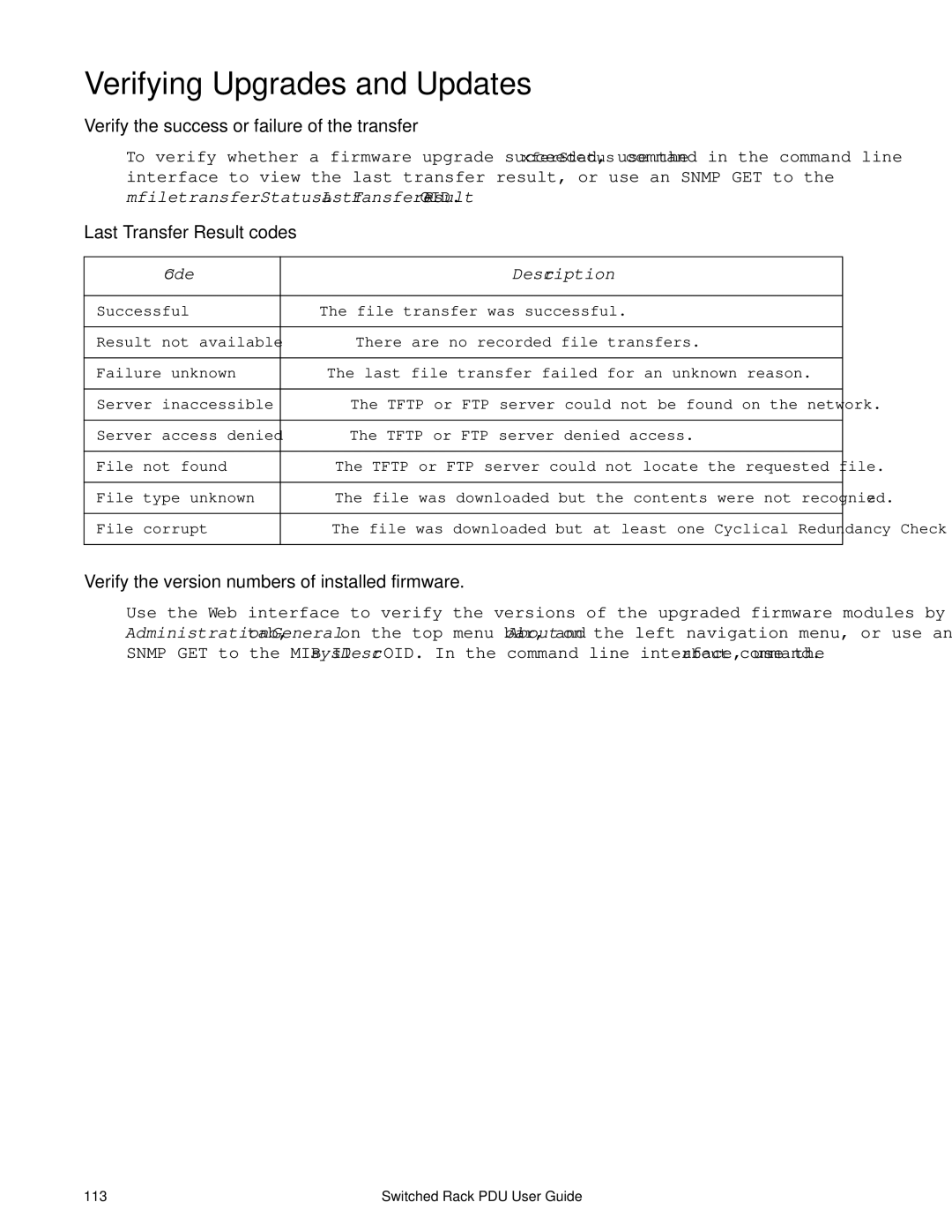User Guide
Contents
Page
Network Port Sharing Commands
Web Interface
Administration Security
Administration Network Features
100
105
Product Features
Introduction
Access Priorities for Logging on
Types of User Accounts
Watchdog Features
Network Port Sharing
Getting Started
Dhcp and Bootp configuration
Establish Network Settings
TCP/IP configuration methods
INI file utility
Option 43 = 01 04 31 41 50
Command Line Interface
Recovering from a Lost Password
Rack PDU Front Panel
Function
Function
Display Tree Example
Display Tree Example
Condition Description
Load indicator LED
Network Status LED
10/100 LED
Log on to the Command Line Interface
Command Line Interface
About the Command Line Interface
Remote access to the command line interface
Local access to the command line interface
About the Main Screen
Using the Command Line Interface
IPv4 IPv6 Description Only
Command Syntax
Description
Command Response Codes
Code Message
About
Network Management Card Command Descriptions
Alarmcount
Option Arguments Description
Clrrst
Boot
Option Argument Description
Console
Argument Description
Date
Delete
Dir
Exit
Dns
Eventlog
Format
Netstat
Option Argument Definition
Help
Ntp
Prompt
Ping
PortSpeed
Quit
Reboot
Radius
System
ResetToDef
Snmp, snmpv3
Tcpip
Tcpip6
User
Web
XferINI
XferStatus
BkLowLoad
Device Command Descriptions
Network Port Sharing Commands
BkNearOver
BkRestrictn
BkOverLoad
BkReading
DevOverLoad
DevLowLoad
DevNearOver
DevStartDly
DevReading
Argument Definition
HumReading
HumLow
HumMin
OlCancelCmd
OlAssignUsr
OlDlyOff
OlDlyOn
OlDlyReboot
OlGroups
OlName
OlOff
OlOffDelay
OlOn
OlOnDelay
OlRbootTime
OlReboot
OlStatus
OlUnasgnUsr
PhLowLoad
PhNearOver
PhOverLoad
PhReading
PhRestrictn
ProdInfo
SensorName
TempReading
TempHigh
TempMax
UserList
UserAdd
UserDelete
UserPasswd
Whoami
Logging On to the Web Interface
Web Interface
Supported Web Browsers
Error Message Browser Cause of the Error
URL address formats
Tabs
Web Interface Features
Symbol Description
Device status icons
Other Web interface features
Quick Links
Group Control using Network Port Sharing
Network Port Sharing on the Web Interface
Switched Rack PDU User Guide
Overview view
Alarm Status view
About the Home Tab
About the Device Manager Tab
Configuring Load Thresholds
Device Management
Viewing the Load Status and Peak Load
Reset Peak Load and kWh
Configure the Name and Location of the Rack PDU
Set the Coldstart Delay for the Rack PDU
Outlet group terminology
Configure and Control Outlet Groups
Set the Overload Outlet Restrictions
System requirements for outlet groups
Rules for configuring outlet groups
Purpose and benefits of outlet groups
Create a local outlet group
Enable outlet groups
Parameters Description
Click Create Local Outlet Group
Edit or delete an outlet group
Create multiple global outlet groups
Click Create Global Outlet Groups
Typical outlet group configurations
Outlet Settings for Outlets and Outlet Groups
Initiate a control action
Control actions you can select
Option Description
Configure outlet settings and the outlet name
Setting Description
Schedule an outlet event
Schedule Outlet Actions
Actions you can schedule
Outlet Manager Menu
Edit, disable, enable, or delete a scheduled outlet event
Configure an outlet user
Outlet Manager and Network Port Sharing
Configure Temperature and Humidity Sensors
Environment
Event log
Logs
Use the Event and Data Logs
Example event log Rack PDU 4 Outlet #2 off
Data log
Path Logs Data options
Parameter Description
Use FTP or SCP to retrieve log files
Scp username@hostnameoripaddressdata.txt ./data.txt
Authentication
Administration Security
Setting user access
Local Users
Radius Setting Definition
Radius
Configuring a Radius server on Unix with shadow passwords
Configure the Radius Server
Summary of the configuration procedure
Supported Radius servers
Inactivity Timeout
Radius and Network Port Sharing
TCP/IP settings
Administration Network Features
TCP/IP and Communication Settings
Dhcp response options
APC Cookie. Tag 1, Len 4, Data 1APC
Port Speed
Ping Response
DNS
Query Type Selected Query Question to Use
Web
Status
Console
Telnet 152.214.12.1145000 telnet 152.214.12.114
Snmp
SNMPv1
SNMPv3
FTP Server
Event Actions
Administration Notification
Configure event actions
Types of notification
Switched Rack PDU User Guide
Active, Automatic, Direct Notification
Mail notification
Send a test message to a configured recipient
Snmp traps
Snmp Trap Test
Syslog
Remote Monitoring Service
Setting Definition
Informational is mapped to Info
Set the Date and Time
Administration General Options
Identification
Mode
Use an .ini File
Daylight saving
Change the default temperature scale
Event Log and Temperature Units
Reset the Rack PDU
Color-code event log text
Configure Links
About the Rack PDU
Use the Wizard
Device IP Configuration Wizard
Capabilities, Requirements, and Installation
Select Locally through the serial port, and click Next
Configure or reconfigure the TCP/IP settings locally
Select Remotely over the network, and click Next
Contents of the .ini file
How to Export Configuration Settings
Summary of the procedure
Retrieving and Exporting the .ini File
Detailed procedures
Ftp open ipaddress
Messages in config.ini
Upload Event and Error Messages
Event and its error messages
Errors generated by overridden values
Firmware File Transfer Methods
How to Upgrade Firmware
File Transfers
Benefits of upgrading firmware
Using the Firmware Upgrade Utility
Use FTP or SCP to upgrade one Rack PDU
Use Xmodem to upgrade one Rack PDU
Using a USB flash drive to upgrade one Rack PDU
How to upgrade multiple Rack PDUs
Using the Firmware Upgrade Utility for multiple upgrades
Firmware Module Binary File
Verify the success or failure of the transfer
Verifying Upgrades and Updates
Verify the version numbers of installed firmware
Last Transfer Result codes
Problem Solution
Troubleshooting
Rack PDU Access Problems
Appendix a List of Supported Commands
Network Management Card Command Descriptions
Sets manual IPv6 address
Device Command Descriptions
Switched Rack PDU User Guide 118
APC Worldwide Customer Support
990-3430C-001 10/2012

